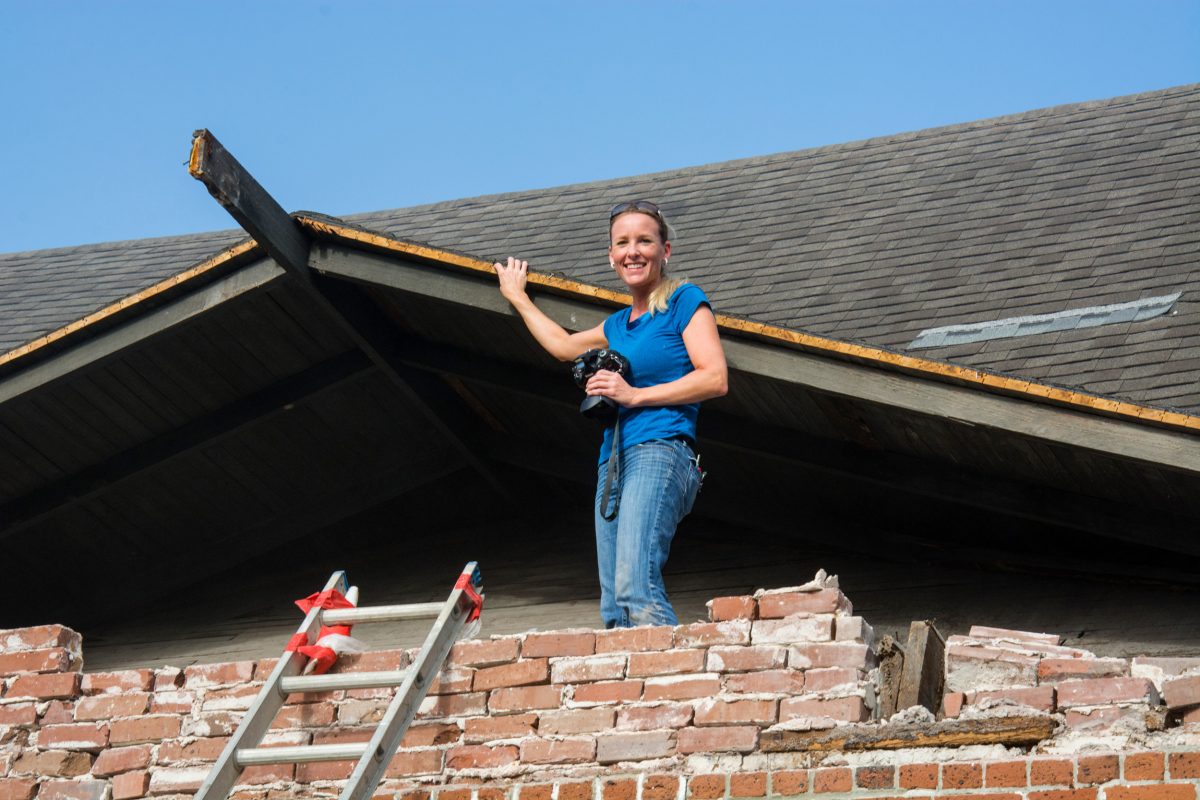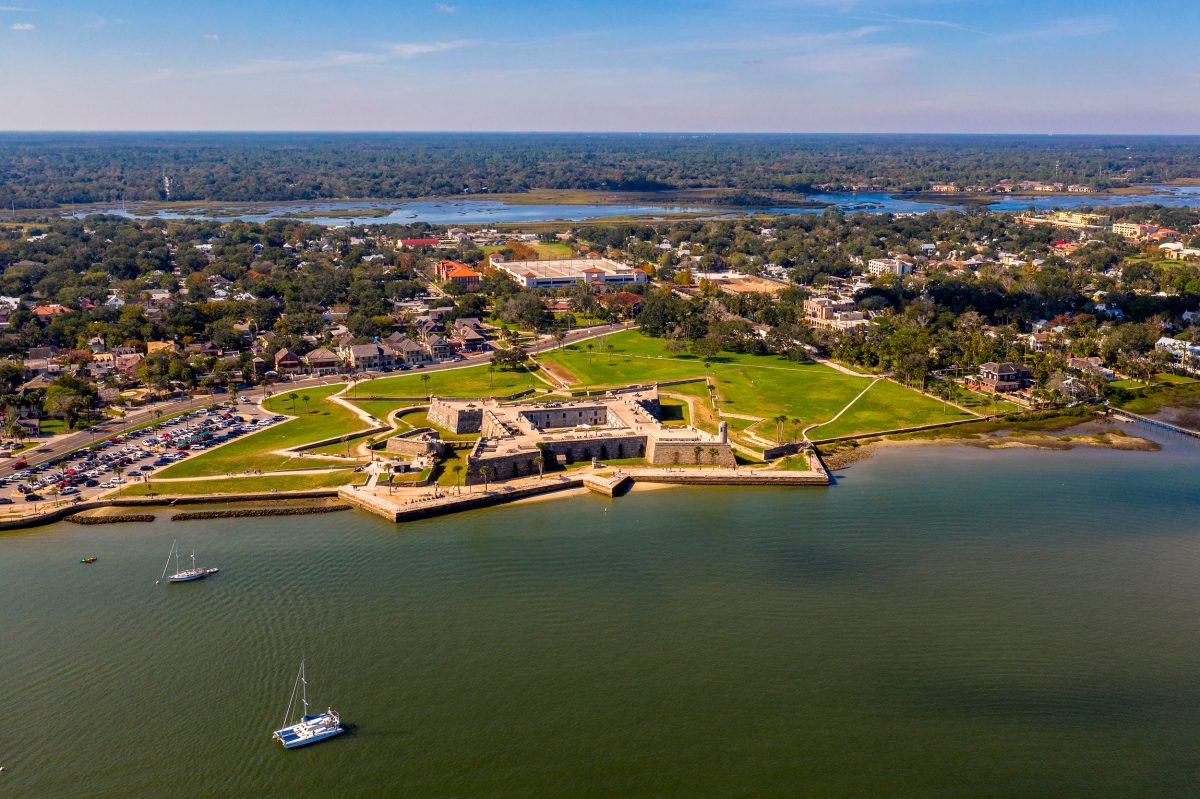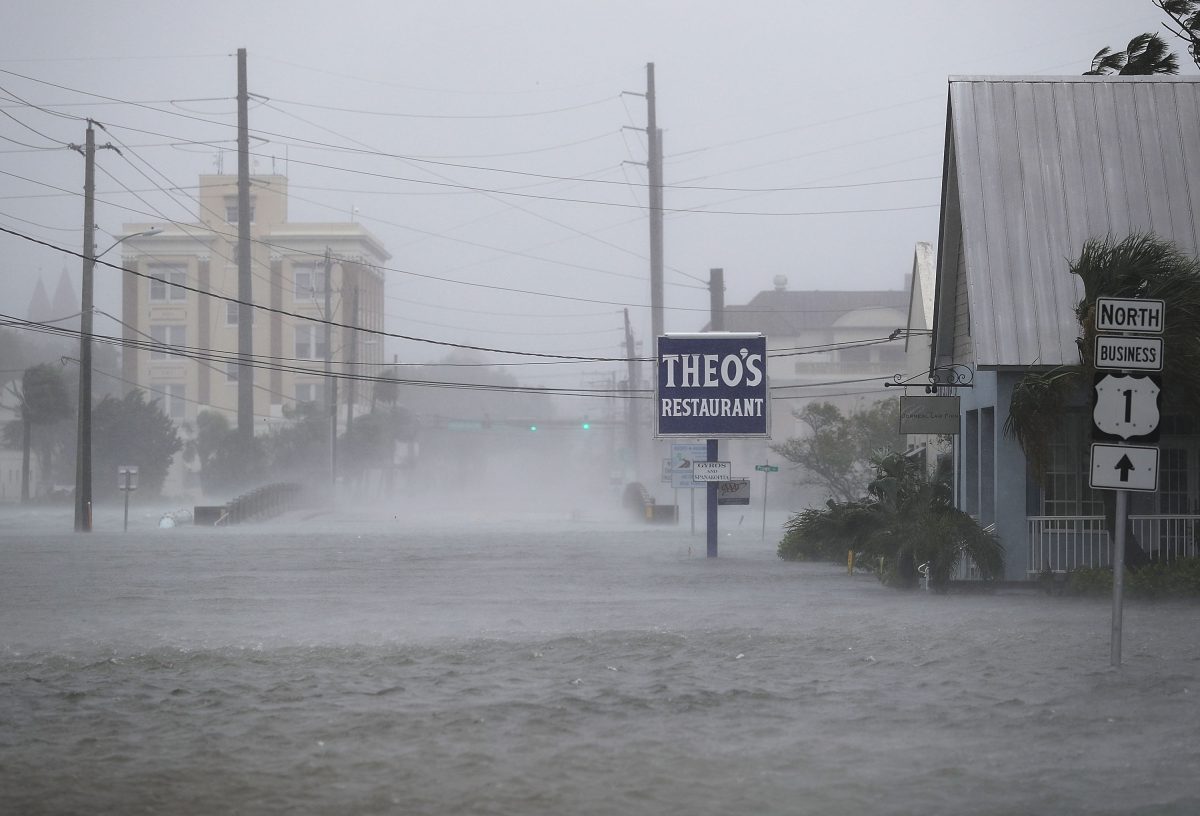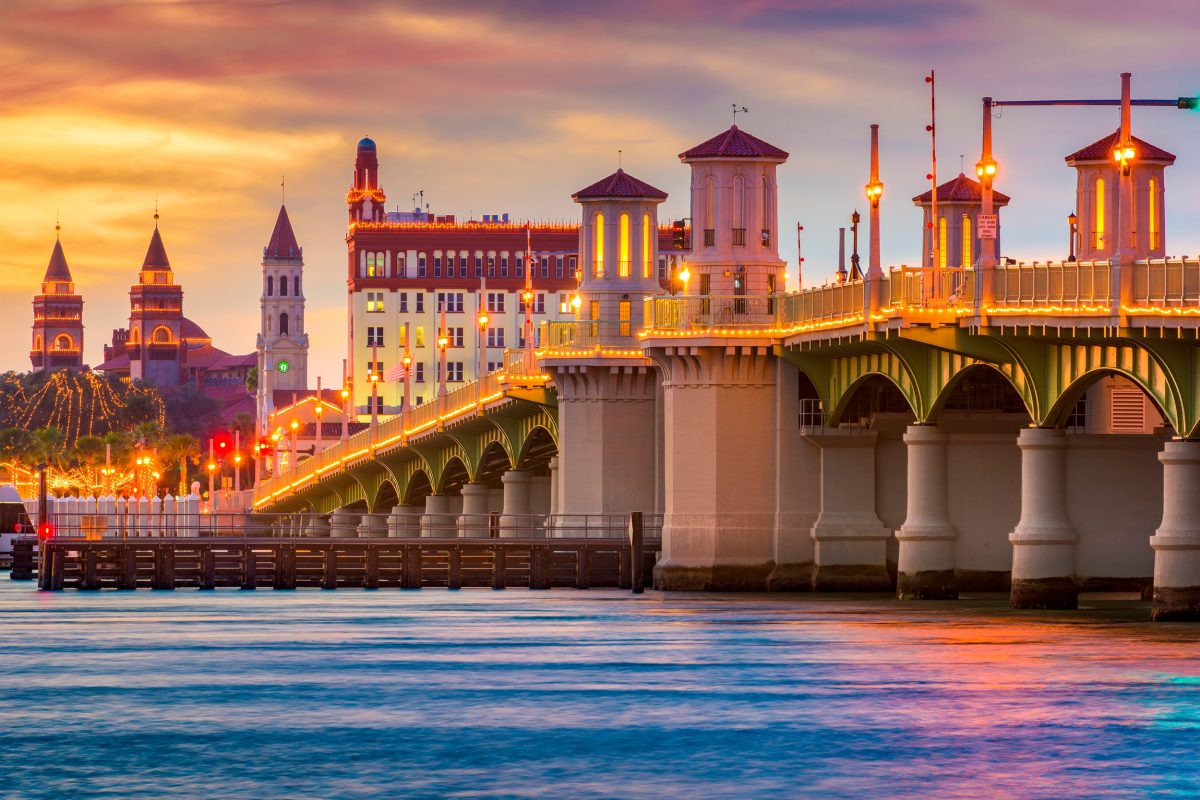The Sea Versus St. Augustine
Rising waters put many historic coastal cities at risk of losing their cultural pasts: can they be saved?
Article body copy
The sky was jarringly blue on a Saturday in October 2016 when Jenny Wolfe drove her car across a bridge into St. Augustine, Florida, to see what remained of her city after Hurricane Matthew.
A small burg of just over 14,000 inhabitants, St. Augustine was founded in 1565 by sailors who claimed Florida for Spain, and it is now the oldest continuously occupied European-settled city in the United States. Wolfe works as its historic preservation officer, and she could read each of the city’s architectural details like chapters in an epic—from early Spanish colonial buildings to the split-level ranch houses built during a 1980s real estate boom. A star-shaped, 17th-century stone fortress called the Castillo de San Marcos—built from coquina, a stone formed by the geological compression of piles of tiny clamshells—is the city’s most iconic structure. The streets are lined with regal 19th-century Spanish Renaissance–style hotels and museums, old drive-in motels with neon signs and turquoise swimming pools, and flashy tourist attractions such as a wax museum, a Ripley’s Believe It or Not! Odditorium, and a pirate museum.
In video footage from the storm, the entire place looked like an underwater ruin, palms flopping limply like grass in wind, streets full of turbulent rivers. Wolfe hadn’t witnessed it firsthand. She’d obeyed evacuation orders and headed inland. There, she anxiously watched her city on news reports and Facebook videos, which showed rampaging floodwaters so high they would have risen, in some places, above her head.

Hurricanes have battered St. Augustine, Florida, since long before European settlement in the 16th century. Storms, however, are increasing in frequency. Irma pounded St. Augustine in September 2017. A year earlier, the city sustained extensive damage when Hurricane Matthew ripped through the area. Photo by Jabin Botsford/The Washington Post via Getty Images
This part of the Florida coast hadn’t seen a hurricane so severe in decades, but in light of predictions about the city’s future, the flood seemed ominous. St. Augustine city officials had already begun to imagine the ways that rising seas might make floods and storms more common and more damaging here. Three months earlier, the State of Florida and the US National Oceanic and Atmospheric Administration had released a study suggesting that just one more meter of water would afflict about 80 percent of the city’s seven historic districts with monthly “nuisance” flooding—an understated phrase for what can become a costly, hazardous, and mold-inducing problem. And an intense hurricane would flood most of the city’s historic buildings. Flood protection poses challenges for any structure, but historic ones have particular vulnerabilities. Even when it’s physically possible to haul a historic building out of harm’s way, put a dam around it, or patch it with modern materials, such changes may erase the details that inform interpretation of its history.
With the waters receded, Wolfe saw how violently the invading sea had trashed the city. “I was driving through—I don’t want to say a war zone—but it felt like you’re going to a site of devastation,” she says. Downed fences. Fallen trees and debris. Signs wrenched off posts. Halloween pumpkins transported by floodwaters, heaped on the street. Sandbags piled on sidewalks.
Wolfe’s office lies inside a palatial former hotel that houses both city hall and an art museum. Though someone had piled sandbags in front of the doors, water had seeped through some windows on the side of the building, flooding a ground-floor conference room and ruining the carpet and flooring. The city was already struggling to reckon with the disasters of the present—never mind those of the future.
That Saturday, Wolfe crossed another bridge—the Bridge of Lions, built in the 1920s. In the previous day’s news footage, it had appeared as a thin line of concrete marooned in churning ocean. On the other side lay Davis Shores, a neighborhood of curving streets where Wolfe lived in a 1940s garage transformed into a cottage. It was mint green with a metal roof, its inner walls covered in heart-pine tongue-and-groove paneling. She loved this place, the way it marked a chapter in the city’s story and in her personal life. It had been a space of her own after she separated from her first husband. But when she arrived that day, she saw that Matthew had strewn the alley in front with trash and bicycles and soaked the rooms inside, ruining an old wedding album and a dresser full of clothes. The place emitted a powerful odor that she would remember vividly but never be able to describe, stranger and more potent than sewage.
By disposition, Wolfe is an organized person—in appearance, fine-boned, with long, blond hair and a heart-shaped face; in manner and dress, neat but not ostentatious, with a formal way of speaking, especially about her city. After sizing up the mess left by the hurricane, she donned rubber boots and gloves to salvage what she could of her home. In the next few weeks, she would turn her attention to the rest of the city, trying to offer as much information to St. Augustinians as she could. Thus equipped, residents could decide how to fix their historic properties, or whether to let them go.

Jenny Wolfe, a historic preservation officer, inspecting the decking of the gable roof of the 1898 historic Waterworks pumping station in St. Augustine. Photo courtesy of Jenny Wolfe
And then, in mid-September 2017, Hurricane Irma plundered the city. All told, the two storms so thoroughly damaged about 40 historic buildings that their owners decided to demolish them. In a time of sea level rise, each of these losses seemed to foreshadow difficult decisions the city would need to make in decades to come. The field of historic preservation has entered a new era, Wolfe feels, in which every act of flood protection is also a choice that shapes the physical remains of history. Places like St. Augustine are at the forefront of this movement. What they do now may help chart a course for many other North American coastal cities—and determine how much of the past they salvage and how much they relinquish.
Historic preservationists and archaeologists have long had a role in stanching the destruction of historic sites and structures when they are threatened by natural disasters, wars, or the dreams and demands of real estate developers. But climate change ups the ante. The global crisis is accelerating losses of all kinds—biodiversity, land, livelihoods, and economies. The erasure of physical history might seem less consequential, but preservationists argue that cultural heritage is both a human right and an essential part of the making and preserving of society and identity. In communities like St. Augustine, history and heritage tourism are also the backbone of the local economy. About a decade ago, historic preservationists began making the case that cultural heritage sites needed their own climate-change adaptation strategies—often distinct from other kinds of engineering and infrastructure.
In a report from a 2008 meeting in Quebec, leaders from the International Council on Monuments and Sites observed that the climate crisis would be a game changer for historic preservation. Structures and buildings that had endured for centuries might fail as “prevailing environmental conditions” morphed, they wrote. They envisioned potentially catastrophic destruction of cultural heritage and warned that “hard choices will need to be made about what to try to preserve.”

St. Augustine’s famed Castillo de San Marcos National Monument. Photo by Rod Clement/Alamy Stock Photo
But it has taken a long time for these ideas to penetrate climate science, community planning, and major institutions involved in historic preservation. In 2015, a gathering of preservationists at the Pocantico Center north of New York City, New York, lamented that the impacts of climate change on cultural heritage hadn’t been “comprehensively addressed in climate policy responses at any level.” The Intergovernmental Panel on Climate Change, the foremost international scientific body studying climate change, has scarcely mentioned risks to cultural heritage in its voluminous reports. Meanwhile, sea level rise and coastal erosion endanger many UNESCO World Heritage Sites, according to the Union of Concerned Scientists. But UNESCO’s reports on World Heritage in Danger have been slow to acknowledge climate change as a threat to historic sites, focusing instead on local and regional hazards, like mining development or military conflict.
Places like St. Augustine face some of the most urgent climate-related challenges. According to one estimate, because of climate change, the risk of high-rainfall Atlantic hurricanes has already increased sixfold between the late 20th century and the 2010s, and the risk will triple again by the 2080s. On top of this, any rise in sea level will allow floodwaters to swell higher and intrude into more parts of the coast. The threat posed by sea level rise is especially dire in Florida, because of the state’s flat topography, and because the sea here is actually rising faster, likely due to an overlap in major atmospheric cycles, El Niño and the North Atlantic Oscillation, that causes water to pile up. Recent projections suggest the waters off Florida’s Atlantic coast will rise 53 to 138 centimeters above year 2000 levels by 2070. By the end of the century, one million of the state’s residential properties will face flood risk, including historic houses like those that line the leafy boulevards and waterfront of St. Augustine. And there are hidden histories—archaeological sites undiscovered or incompletely documented—that could disappear altogether. One report states that just a meter of sea level rise will endanger as many as 13,000 archaeological sites on the Gulf and Atlantic coasts of the southeastern United States.
As a result, preservationists and archaeologists must increasingly act like disaster responders—performing triage on pieces of cultural history. In the past few years, the solutions under consideration have ranged from conventional to unusual: barriers like the massive and costly sea gates being built around Venice, Italy; designs by an Ontario architect and professor for retrofitting historic buildings with “amphibious” foundations that would float on the water’s surface when floods arrive; hydraulic lift systems that haul buildings upward when the water rises; and inflatable plastic flood barriers that can be discreetly stowed when floods recede.
Large-scale disaster planning is an unfamiliar role for many preservationists, but not for Leslee Keys, a professor and the director of historic preservation at Flagler College, whose campus sits across the street from St. Augustine’s old hotel turned city hall, where Jenny Wolfe works.
“I’m not afraid of hurricanes,” Keys says matter-of-factly. “But I’m really efficient when it comes to being prepared for them.” She forged that expertise after Hurricane Andrew galloped across the southern coast in 1992, when she took a job in the Florida Keys, the small necklace of islands that extends from the bottom of the state. During her years there, she trained librarians and curators to make plans to protect their collections from storms. “If you’re down to that 72-hour window [before a hurricane], you should know how many hours it takes you to do particular things,” like pack up antique furniture and pottery, board up windows, or store archives and rare books well above flood elevation. She also helped restore buildings damaged by Andrew, using some of the same techniques relevant to preparing for sea level rise. “We were working with retrofitting buildings … by armoring them from the outside,” she recalls, “building them back in a way they would still look historic but would have more resilience.”

Leslee Keys, assistant professor and the director of historic preservation at St. Augustine’s Flagler College, in the college’s architectural gem, the former Hotel Ponce de Leon’s Grand Parlor. Photo by Really Swell Photography
In 2013, after moving to St. Augustine and working and studying her way into her current role, Keys began collaborating with Wolfe and others from the city on issues like resiliency planning—that is, the ability to withstand and recover from future disasters. She was also trying to mobilize St. Augustinians to consider sea level rise. It felt like the culmination of a life’s work. But Keys recognized that the hurricane-recovery strategies she had learned and promoted in the past would only go so far when the waters rose and hurricanes turned more often into superstorms. “I hate to think that everything that I have done for the last 40 years is now going to be gone because sea level rise has not been addressed,” she reflects. “So it’s very personal.” She planned a local workshop in 2016 to discuss the issue, with Wolfe as a speaker, along with experts from all over Florida. The workshop was to be held in the very city hall conference room that ended up flooding, three weeks before the scheduled meeting time, during Hurricane Matthew. Keys still held the gathering, in a nearby, non-drenched location, where attendees discussed everything from building codes to the preservation of Ernest Hemingway’s house outside Havana, Cuba.
The floods of Matthew were like a test run for sea level rise, laying St. Augustine’s structural and political weaknesses bare. Major landmarks throughout the city fared relatively well. For instance, the Castillo de San Marcos, which stands on a hillock inside a dry moat, looked as if the storm had barely touched it, while the National Park Service offices at the edge of the grounds got a thorough soaking.
Many private owners of historic properties took a serious hit, and not all had the financial means for repairs. Wolfe quickly learned that federal agencies would not come to such households’ immediate rescue. Anyone who needed personal financial assistance from the US Federal Emergency Management Agency, or FEMA, had to fill out paperwork and leap bureaucratic hurdles. “FEMA wasn’t coming out to help us out,” she recalls with exasperation in her voice. “We had to go to each of our 8,000 buildings in the city with our small staff and check a box [on a form].” In response, city staff recruited local citizens to help. Keys gathered a group of students to walk with her to restaurants and shops in the downtown core and help them file for disaster recovery money.

Hurricane Matthew was so powerful that five southeastern states, including Florida, declared a state of emergency before it hit the coast. Photo by Joe Raedle/Getty Images
Wolfe began knocking on doors in the blocks south of city hall—the Lincolnville neighborhood, established by freed slaves after the Civil War, now filled with Victorian houses with wide, breezy porches. Signs throughout the neighborhood mark the Freedom Trail, houses and churches where Dr. Martin Luther King Jr. gathered with other activists during the American civil rights movement before and after holding rallies and sit-ins that would lead to mass arrests. Wolfe spoke with a mother and adult daughter here. “One of them has asthma. They had to relocate to an apartment off of US 1 [a busy highway],” she remembers. The mother’s uncle had built the house himself and given it to them. But money was tight, and repairs seemed daunting. (More than three years later, the repairs still haven’t started, though they’ve been approved.) Wolfe also met an African-American grandmother sorting through her belongings inside a dark bungalow with a screened-in porch. The house was raised up about a third of a meter above the ground on columns called piers, but it had still filled with water. Books, clothing, photographs were stacked on the floor, drying. “I just remember feeling her sense of bewilderment,” Wolfe says.
In the months that followed, the city reviewed dozens of applications seeking permission to either demolish or gut buildings in the historic district—erasing architectural details that form the city’s story, little chapters and subplots vanishing. Dozens of homeowners applied to raise their foundations on high piers; each request had to be carefully reviewed so that the modifications wouldn’t distort the aesthetic and legacy of St. Augustine.
By May 2017, Wolfe and her colleagues had mostly taken stock of the damage, with help from the University of Florida, and put together plans for how to address flooding in a time of rising seas. The report recommended infrastructure improvements such as upgrading the storm water drainage system, along with educating the public. It also warned that “St. Augustine’s historic districts are vulnerable, immovable, and irreplaceable.” Moreover, “many residents seem not to know what’s coming.”

Hurricane Matthew left its mark on several blocks of Magnolia Avenue in St. Augustine. Photo by ZUMA Press Inc/Alamy Stock Photo
In September 2017, when Hurricane Irma arrived in the city, floodwaters gushed into some of the same houses and buildings that had only just been repaired.
On the one hand, the city was more prepared this time. “We knew what to do to help us plan in advance,” says Wolfe. On the other, this second storm dealt a traumatic gut-punch to some property owners who were just beginning to recover. The city tried to target some disaster response money toward adaptation, but ironically, at the time, many state and federal grants would only support repairs after disasters, not the prevention of damage before a future catastrophe. More recently, the National Park Service has provided the city with some funding for flood-related planning. Still, if the future looks like this—flood after flood—it could be difficult for a small place like St. Augustine to keep up with repairs, let alone get ready for the next disaster.
Though the US federal government provides some assistance, the preservation of historic sites—even places of international significance—is foremost a local responsibility, and climate change is putting increasing strain on small communities like St. Augustine. After Matthew and Irma, it became clear that St. Augustine needed much more help. Leslee Keys applied to bring an international conference to the city in 2019 with the evocative name Keeping History Above Water, an unusual gathering of preservationists, archaeologists, coastal engineers, disaster responders, climate scientists, and other experts attempting to salvage history from the rising seas. In early May, 235 people gathered for discussions in St. Augustine’s historic hotels and for a wine reception in the now-water-free ground floor of the hotel turned city hall. The attendees included a group of engineers from the US Naval Academy in Annapolis, Maryland—which also faces a serious flooding problem. They walked along the waterfront with city staff and agreed to assign students from the academy to study the section of sea wall that runs alongside the Castillo de San Marcos and recommend design solutions.
Meanwhile, St. Augustine’s public works department has already raised one section of sea wall and is redesigning the storm water system around an artificial lake, replacing a bulkhead, adding a pump station, and swapping out valves so that floodwaters don’t rise up through storm drains. Recently, the city contributed funds to haul a historic 1940s house—from a part of the Davis Shores neighborhood that floods more than two dozen times a year—to the Florida Agricultural Museum 30 kilometers southwest. The city’s public works department now plans to lift and fill several pieces of land in the Davis Shores location until they are above Hurricane Matthew’s more-than-two-meter high-water mark. This is also the estimated flood height of a minor storm after nearly half a meter of sea level rise. Over time, the city plans to keep raising sea walls, boosting foundations, and upgrading infrastructure until all of St. Augustine is protected from Matthew-sized floods.

Connecting downtown to Anastasia Island, St. Augustine’s Bridge of Lions is listed on the National Register of Historic Places in the United States. Photo by Sean Pavone/Alamy Stock Photo
Proactive steps like these may buy St. Augustine decades of time, relief from flooding at high tide, and more protection against tropical events. The city has also applied for funding from the US Army Corps of Engineers to research more creative and radical engineering solutions—from modest “living shorelines,” which use plants and natural materials to stop coastal erosion, to a massive sea barrier or gate like some that exist in the Netherlands. In November 2019, St. Augustine hired a full-time chief resilience officer, their former public works director, who is leading all of these efforts.
Some of these strategies might extend the city’s longevity even further. But there are limits to holding back the sea. Andrea Dutton, a geologist who spoke at the conference, explained that her research on warmer eras in Earth’s ancient past suggests that more than six meters of sea level rise may be inevitable—though other researchers have estimated that such extreme changes in sea level might take centuries or millennia. St. Augustine has lasted an impressive 450 years, but it may never reach the longevity of, say, the several-millennia-old city of Damascus, Syria, or the eight-century-old metropolis of Berlin, Germany. But if the city planned well for floods—and if the world actually took more substantial action to keep global warming from accelerating—St. Augustine might endure for a while. “If, for 100 years more, people get to enjoy it, isn’t that worth something?” asks local archaeologist Carl Halbirt.
On the last day of the conference, Wolfe borrowed one of the city’s white Chevrolet trucks and assembled an ad hoc tour spotlighting the post-hurricane reconstruction of St. Augustine for four historic preservationists from out of town. Wolfe wore blue jeans and a royal-blue polo shirt embroidered with the St. Augustine crest, her hair loose, her feet in sandals. She knew all four women taking the tour from her years in graduate school and subsequent professional events, and they cracked jokes and fired questions at her. Wolfe proceeded slowly down the waterfront boulevard, Avenida Menendez, named for the city’s founder, Pedro Menéndez de Avilés. She stopped the truck in front of a row of houses, most from the early 20th century, at varying heights.
Here was a wood-shingle building that had been elevated an extra 60 centimeters to nearly three meters above the high-tide line and was still in construction, the walls covered in black tar paper. Beneath it, the contractors had discovered coquina piers of unknown vintage. Here was a Mediterranean Revival house with hollow clay tiles and arched doorways. The first floor filled with water during both hurricanes. The owner refused to evacuate during Irma. “He has video where he’s standing on his porch, and the water is just sloshing around,” Wolfe recalled. Rather than give up on the house, he decided to convert his first floor into a waterproofed porch and live upstairs. Here, at the front of a house, stood a wall maintained by a private resident, a replacement of an older wall—the water from Hurricane Irma had retreated so quickly that the pressure sucked it toward the sea and broke it into pieces. The new wall, of coquina and concrete block, was a couple of feet higher.
Wolfe drove on, looping away from the waterfront and into Lincolnville. Oaks draped with Spanish moss leaned over the streets. Here was an empty lot where a house had been torn down, and another demolition, the site of an African-American community center that had been derelict and too expensive to fix after two storms and decades of deferred maintenance.
Wolfe crossed the bridge into Davis Shores. She no longer called this neighborhood home. After Matthew, the return to her cottage had triggered too many feelings of loss and vulnerability, and she had decided to move in with her then-boyfriend, now her husband. Here were houses on wide, grassy lawns, then more empty lots, then a ranch elevated in defiance of the traditional low-to-the-ground style for such a house. Here were the tiny, rectangular dwellings put up after the Second World War. Here was an unobtrusive green city park where an archaeologist was searching for remnants of a second Spanish settlement.
Wolfe argues that it is all historic, from the plain to the grandiose, all pieces of a story. And part of her job is to help ensure it remains legible, even if the details must be edited to protect the place from more storms.
She rounded a corner, and a tiny green house came into view behind a broken chain-link fence. “This is where I used to live,” she said.
“It’s so cute,” one of the women exclaimed.
Wolfe looked wistful for a moment. “I lost the place that I felt very content.”

